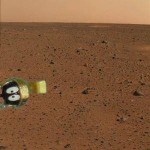The Nina, the Pinta and the Santa Maria, oh, and Curiosity

It was 520 years ago that Queen Isabella of Castile, a country which would eventually become the nation of Spain, finally acquiesced to Christopher Columbus’s constant pestering and coughed up enough dinero to finance the first of four sailing expeditions for which he would become most famous. The intent here was to find a sea route to Asia and the West Indies, which was deemed to be an improvement over the existing land routes to the west and had the potential of bringing vast wealth and riches to those involved. Chris was convinced the earth was round, and he managed to convince the Queen and her cohorts that, hey, this could actually work. (I am inclined to believe he was probably a better salesman than a sailor–read on.) Word has it, though, that Chris vastly underestimated the size of the planet. And it didn’t occur to him, apparently, that there might be something between him and Asia to west. It also turns out that he wasn’t exactly the cat’s meow when it came to navigating.
To begin with, these three vessels were actually built for sailing on the Mediterranean Sea rather than the ocean. They were tiny at about fifty feet in length, or about the same size as a modern-day Florida shrimp boat. The little ships were each packed tight as a tick with supplies and carried a crew of about twenty or so for what turned out to be about a ten-week passage (one-way).
Well, we know things could have gone better for Mr. C. First of all he managed to discover the wrong continent. It also turned out that he initially landed on a small Bahamian island, where he promptly stuck a flagstaff in the sand and claimed ownership in the name of his benefactors, the King and Queen of Castile, overlooking the fact that the people living there (whom he referred to as Indians, since he was cocksure he had made it to the West Indies) might not consider that to be such a great idea. (This seemed to be a recurring problem with European explorers, by the way.) Next, he continued west, more or less, and landed on the island of Cuba, which, for reasons unexplained, he presumed to be Japan. (Jeez, I think he may have been missing some important clues here, but, perhaps, he had never actually met a citizen of Japan.)
But, in the long run, things turned out pretty well–for the Europeans, anyway.
What brought all this to mind was the recent successful launch, voyage and safe landing of Curiosity, the aptly named and newest Mars rover. First of all, kudos to the team that successfully managed to send a self-propelled vehicle the size of a small car 563 million miles through space, to land within about ten feet of their target without so much as a fender ding. And, I must say, this rover has the added appeal of looking a lot like my most favorite robot of all time, Wall-E (certainly, you have seen this movie). I am genuinely excited about this adventure and will be keeping up with its progress on a regular basis.
As a species, we’ve come a long way since 1492. We are a lot better at navigating, and our expectations of the outcome of this expedition are by no means any less exciting than those of Christopher Columbus.
One comment
Death may have been a result of too much exploring or the wrong kind.
Nevertheless both events were and are ground breaking for our human
kind.